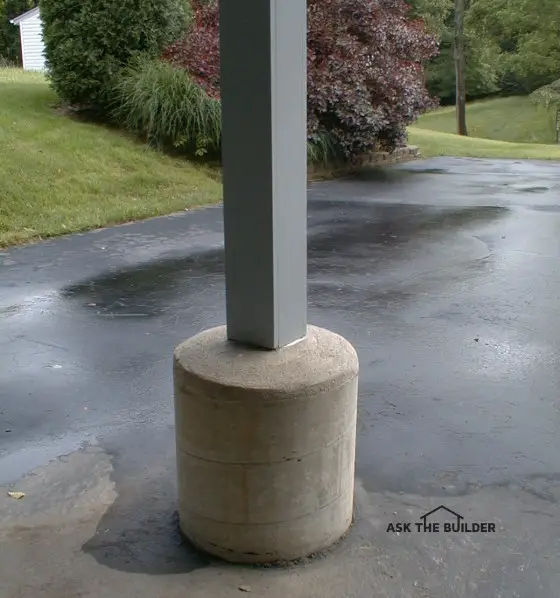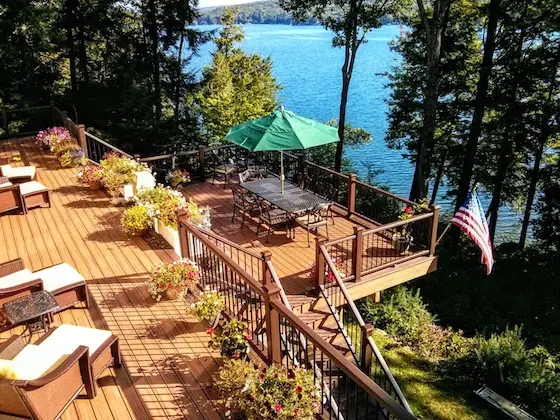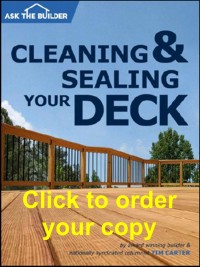Deck Piers and Footings
Deck Piers and Footings

Deck Pier Footing | Once a deck pier is installed, it's fairly difficult to determine how far it extends into the ground. This pier is twenty feet deep. I know because I installed it!
DEAR TIM: I am building a deck and wonder how far down I have to dig into the ground for the wood deck post. I had been told it must extend to the freeze/frost line. What/where is that? What diameter should the hole be? Is there a need for steel in this pier? Joanne C., Hanover, PA
DEAR JOANNE: The freeze or frost line is the depth to which the soil freezes or has been known to freeze at some point in the past. It is absolutely critical that the foundations of buildings extend below this point in a soil profile. Except for a few arid locations, soils typically contain water and this water expands approximately nine percent in volume when it freezes. The resulting pressure created as the water expands is so great it can actually lift concrete slabs, house foundations and deck structures with as little effort as an Olympic weight lifter expends picking up his gym bag as he leaves the locker room.
How Deep is the Frost Line?
The frost line depth is not consistent around the nation because there is such a dramatic difference in climate from state to state. The frost line in southern Florida is less than a foot, while in northern Minnesota it approaches 6 or even 8 feet.
The best source of information regarding your frost line depth is your local building department. These individuals perform daily inspections on jobs such as yours to ensure two things: the hole is the proper depth and the soil at the bottom of the hole is strong enough to support the concentrated loads being placed upon it.
Building a deck? Make the best decisions with my helpful and thorough Deck Installation & Repair Checklist. I offer a 100% Money Back Guarantee.
How is the Diameter of Piers Determined?
The diameter of the holes for your deck piers is not a number pulled out of the air. You may get the answer from your building inspector or you may have to consult with a seasoned architect or structural engineer.
How Much Do Decks Weigh?
Decks, especially large ones, create significant concentrated loads within the soil. If you calculate the weight of the entire deck, the furniture placed on it, and the combined weight of a large group of people who might be standing on it, you will be shocked at the number. Even a small deck might weigh in at 4,000, or more, pounds. The two connected decks at my house, one is 10 x 65 and the other is 24 x 16 could tip the scales at 12,000 pounds when you count all the lumber, decking, handrails, furniture, plants, etc. Look for yourself:

Here's my own Trex Transcend deck. There's lots of railing. You're only seeing about 60% of the long upper deck in this photo. Copyright 2020 Tim Carter
If your deck is like most where it has two wooden deck posts and a rim joist that is bolted to the house, each of the two deck posts holds up approximately 25 percent of the total weight. In your case, the soil under each deck post may be called upon to support 3,000 or more pounds without flinching.
 What size and shape should the hole be?
What size and shape should the hole be?
The diameter of the hole will probably be no larger than 24 inches in diameter and may be as small as 12 inches. Larger diameter holes spread the weight out over more soil area.
What is perhaps far more important is the shape of the hole as you dig it. All too often people dig post holes for deck piers and fence posts that look like an ice cream cone or a paper ice-ball holder - the bottom of the hole being smaller than the top of the hole.
Surely you've had an ice-ball in your hand on a summer day and squeezed the paper cone. The ice pops upwards with ease. Frost does the same thing with a hunk of concrete that's cone-shaped. Frost can heave a pier up 4 to 6 inches with ease.
Should a Deck Pier Hole Be Wider at the Bottom?
In fact, the shape should be the exact opposite. The bottom 25 percent of the pier hole should be larger than the top. As the frost drives deeper into the soil and tries to force the pier upwards, the flared base acts as a wedge anchor. For the pier to lift upwards the enlarged base would have to tear through the frozen soil. This is highly unlikely. The larger diameter base also helps spread the concentrated load over an even greater area.
Watch this video about how wedge anchors work in concrete block. It's the same principal for your deck piers when they combat frost heave:
Should I Use Reinforcing Steel?
Be sure to include two or three pieces of vertical reinforcing steel in the concrete as you pour the pier. This low-cost item adds enormous strength to piers that are taller than 30 inches. Long concrete piers poured on hillsides are subject to lateral or sideways soil pressure as the soil creeps downhill over time. The steel will help prevent the pier from cracking in two from this pressure.
CLICK or TAP HERE to get FREE quotes from local companies who can install a deck for you.
How Can I Center the Deck Post on the Pier?
If you want your wooden deck posts to be dead center in the middle of the concrete pier, then you need to be an expert surveyor or a person who builds deck like I do. Centering the deck posts is easy if you have the outline of the deck built and suspended in the air. This is very simple to do.
Start by attaching the rim joist to the house. Attach the two end joists of the deck to the rim joist using joist hangers. Temporarily support the other end of the joists with a piece of lumber making sure the joists are level. Nail the outer joist to the ends of the two joists that extend from the house. The outline of the deck is now complete. Check to ensure the deck outline box is both level and square.
Once the deck outline is square, drop a plumb bob from the corners to establish these points down at ground level. Use these reference points to easily locate the proper pier locations.
Related Links:
Column 519
4 Responses to Deck Piers and Footings